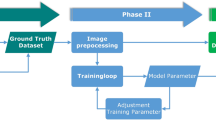Abstract
Deep learning has demonstrated promise for cardiac magnetic resonance image (MRI) segmentation. However, the performance is degraded when a trained model is applied to previously unseen datasets. In this work, we developed a way to employ a pre-trained model to segment the left ventricle (LV) and quantify LV indices in a new dataset. We trained a U-net with Monte-Carlo dropout on 45 cine MR images and applied the model to 10 subjects from the ACDC dataset. The initial segmentation was refined using a continuous kernel-cut algorithm and the refined segmentation was used to fine-tune the pre-trained U-net for 10 min. This process was iterated several times until convergence and the updated model was used to segment the remaining 90 patients in the ACDC dataset. For the test dataset, we achieved Dice-similarity-coefficient of 0.81 ± 0.12 for LV myocardium and 0.90 ± 0.09 for LV cavity. Algorithm LV indices were strongly correlated with manual results (r = 0.86–0.99, p < 0.0001) with marginal biases of –8.8 g for LV myocardial mass, –0.9 ml for LV end-diastolic volume, –0.2 ml for LV end-systolic volume, –0.7 ml for LV stroke volume, and –0.6% for LV ejection fraction. The proposed approach required 12 min for fine-tuning without requiring manual annotations of the new datasets and 1 s to segment a new image. These results suggest that the developed approach is effective in segmenting a previously unseen cardiac MRI dataset and quantifying LV indices without requiring manual segmentation of the new dataset.
Access this chapter
Tax calculation will be finalised at checkout
Purchases are for personal use only
Similar content being viewed by others
References
Bai, W., et al.: Automated cardiovascular magnetic resonance image analysis with fully convolutional networks. J. Cardiovasc. Magn. Reson. 20(1), 65 (2018)
Bernard, O., et al.: Deep learning techniques for automatic MRI cardiac multi-structures segmentation and diagnosis: is the problem solved? IEEE Trans. Med. Imaging 37(11), 2514–2525 (2018)
Flachskampf, F.A., Biering-Sørensen, T., Solomon, S.D., Duvernoy, O., Bjerner, T., Smiseth, O.A.: Cardiac imaging to evaluate left ventricular diastolic function. JACC Cardiovasc. Imaging 8(9), 1071–1093 (2015)
Gal, Y., Ghahramani, Z.: Dropout as a bayesian approximation: representing model uncertainty in deep learning. In: International Conference on Machine Learning, pp. 1050–1059 (2016)
Grothues, F., et al.: Comparison of interstudy reproducibility of cardiovascular magnetic resonance with two-dimensional echocardiography in normal subjects and in patients with heart failure or left ventricular hypertrophy. Am. J. Cardiol 90(1), 29–34 (2002)
Guo, F., Krahn, P.R., Escartin, T., Roifman, I., Wright, G.: Cine and late gadolinium enhancement mri registration and automated myocardial infarct heterogeneity quantification. Magn. Reson. Med. 85, 2842–2855 (2020)
Guo, F., et al.: Improving cardiac MRI convolutional neural network segmentation on small training datasets and dataset shift: a continuous kernel cut approach. Med. Image Anal. 61, 101636 (2020)
Guo, F., Ng, M., Wright, G.: Cardiac cine MRI left ventricle segmentation combining deep learning and graphical models. In: Medical Imaging 2020: Image Processing, vol. 11313, p. 113130Z. International Society for Optics and Photonics (2020)
Kirby, M., et al.: Hyperpolarized 3he and 129xe MR imaging in healthy volunteers and patients with chronic obstructive pulmonary disease. Radiology 265(2), 600–610 (2012)
Leiner, T., et al.: Machine learning in cardiovascular magnetic resonance: basic concepts and applications. J. Cardiovasc. Magn. Reson. 21(1), 1–14 (2019)
Members, W.C., et al.: Accf/acr/aha/nasci/scmr 2010 expert consensus document on cardiovascular magnetic resonance: a report of the american college of cardiology foundation task force on expert consensus documents. Circulation 121(22), 2462–2508 (2010)
Radau, P., Lu, Y., Connelly, K., Paul, G., Dick, A., Wright, G.: Evaluation framework for algorithms segmenting short axis cardiac MRI. MIDAS J.-Cardiac MR Left Ventricle Segment. Chall. 49 (2009)
Ronneberger, O., Fischer, P., Brox, T.: U-Net: convolutional networks for biomedical image segmentation. In: Navab, N., Hornegger, J., Wells, W.M., Frangi, A.F. (eds.) MICCAI 2015. LNCS, vol. 9351, pp. 234–241. Springer, Cham (2015). https://doi.org/10.1007/978-3-319-24574-4_28
Shen, D., Wu, G., Suk, H.I.: Deep learning in medical image analysis. Ann. Rev. Biomed. Eng. 19, 221–248 (2017)
Author information
Authors and Affiliations
Corresponding author
Editor information
Editors and Affiliations
Rights and permissions
Copyright information
© 2021 Springer Nature Switzerland AG
About this paper
Cite this paper
Guo, F., Ng, M., Roifman, I., Wright, G. (2021). Cardiac MRI Left Ventricular Segmentation and Function Quantification Using Pre-trained Neural Networks. In: Ennis, D.B., Perotti, L.E., Wang, V.Y. (eds) Functional Imaging and Modeling of the Heart. FIMH 2021. Lecture Notes in Computer Science(), vol 12738. Springer, Cham. https://doi.org/10.1007/978-3-030-78710-3_5
Download citation
DOI: https://doi.org/10.1007/978-3-030-78710-3_5
Published:
Publisher Name: Springer, Cham
Print ISBN: 978-3-030-78709-7
Online ISBN: 978-3-030-78710-3
eBook Packages: Computer ScienceComputer Science (R0)




